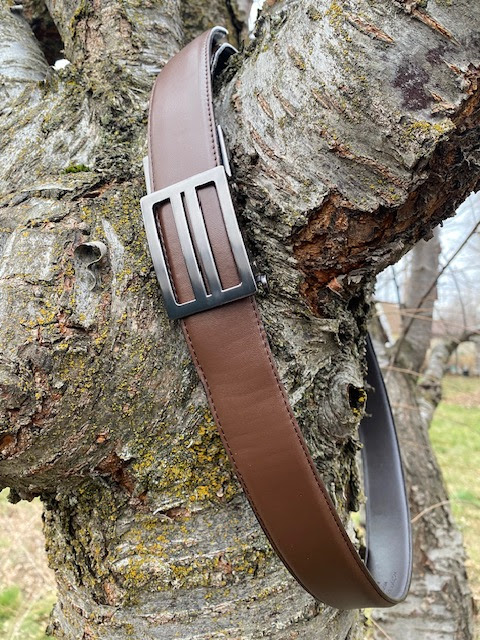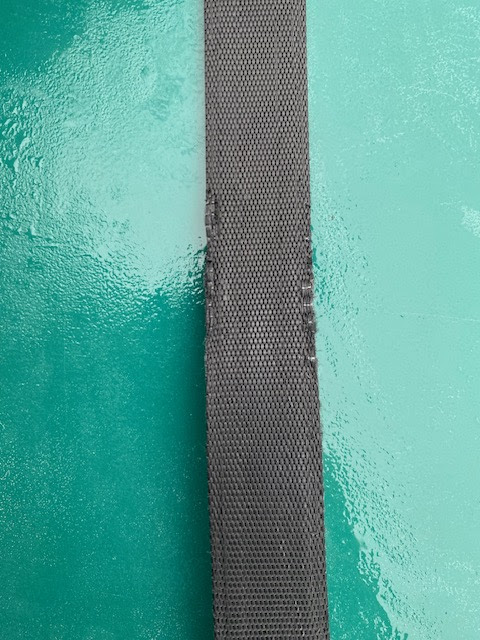Kore Essentials make what seems to be a fairly popular line of gun belts that use a ratcheting system for tightening up the belt, and a plastic core that makes it more rigid. They have two basic styles of standard gun belt: (1) A nylon belt with a rubberized backing that I've seen described as the same or similar to the material used in conveyor belts. These are offered in several different colors as well as a few camo patterns. And (2) a faux leather appearing belt that I know is at least offered in brown and black.
The advantage of the ratcheting system is that it allows for finer adjustments of approximately 1/4 inch when tightening or loosening the belt. The photograph below shows a close up of the ratcheting system on the belt buckle and the "track" that it uses.
 |
| Close up of ratcheting system. |
Between my eldest son and myself, we've owned and used several different Kore belts over the past several years, including both the standard nylon models and the dress belts.
 |
| Faux leather dress belt |
The first belt I picked up for myself was a brown faux leather model to use for business wear (pictured above), which I only ever wore two times per week (I alternated it with a black leather dress belt during the work week, and use a different belt for casual wear). I went with Kore because I liked the styling (they looked nice) and the rigid core which I hoped would lessen the holster flop you can get at the end of the day when a gun belt has stretched just a bit. I used it for a year without much issue when I somehow picked up a rather unsightly scratch or scrape on the back of the belt. Over the next couple of years it picked up other scratches and scrapes so that it now unusable as a dress belt.
 |
| Close up of some of the scratches/scrapes. |
 |
| Showing more of the scratches/scrapes. |
Another problem that cropped up is that the plastic core does not extend the full length of the belt, so that the belt did deform over time, as you can see in the photograph below. The stretching and deformation can be managed simply by alternating the direction of the belt, but I bought the belt because of the plastic core that was supposed to prevent that type of thing.
 |
| Deformation of the dress belt from use. |
And when I was taking pictures for this review, I noticed that even the edges of the belt had started to crack and degrade.
 |
| Edge of dress belt. |
Keep in mind that this was not the result of heavy use: I typically only wore it twice per week to an office job. In any event, I switched about 12 months ago to using a brown, genuine leather dress belt.
 |
| Standard nylon style belt. |
I also purchased one of the standard nylon belts about 2 years ago (pictured above). Mine is still in good shape because I've only worn it a couple dozen times at most. But about the time I purchased my faux leather belt, my oldest son picked up a standard nylon one to use for everyday wear. He is now on his third belt of that type (which he has had for about a year), and it is already wearing out. He was kind enough to lend it to me for some photographs, below:
 |
| The tip of the belt is still in pretty good shape, but you can see some fraying starting to develop. |
 |
| Extensive fraying and wear on the edges of the belt. |
 |
| A small matter, perhaps, but when talking the photographs I noticed some discoloration on one side of the buckle where it looked like some of the finish was wearing off. |
 |
| You can see the fraying from the back of the belt, as well as cracking of the rubberized parts of the belt. |
 |
| Another view showing how the backing of the belt was deteriorating. |
My son also used one of the faux leather belts, but had to replace it about a year ago even though he typically only wore it for Sunday wear to church (i.e., once per week).
Kore's warranty is only for 1 year. Perhaps they envision that people will replace their belts every one to two years. But for about the same price as a Kore belt, one can get a basic leather belt that will last far longer. In short, my experience and the experience of my son is that the Kore belts wear out after about 1 to 2 years even with only moderate use.
Nexbelts hold up a little better. Their plastic core runs the entire belt but does not like the pressure some Kydex OWB holsters put on it and crack through at the stress point. The belt still functions but the broken core starts wearing the nylon faster at that point. Leather OWB fare better as the holster flexes. Some stitching likes to unravel particularly on the edge of the exposed ratchet rail but a drop of superglue fixes that. Without the sharp bending caused by the Kydex OWB I get about 2 years out of one. I like the 1/4" adjustment too much to go back to leather belts. Stiff enough for good support of a full size firearm.
ReplyDeleteI have an old, thick leather belt that has held up over many years, so I use that on weekends (part of the reason my nylon Kore belt has seen so little use). My son is going to go with a thick leather belt as well for his EDC belt; and he already switched back to a leather belt for a Sunday dress belt.
Delete